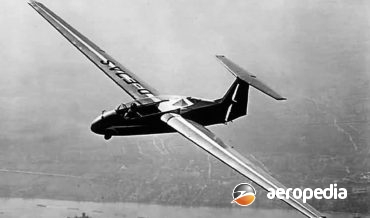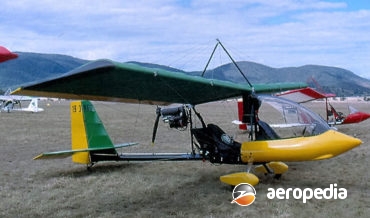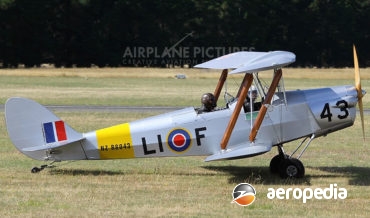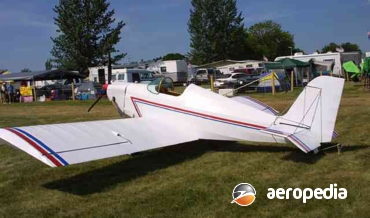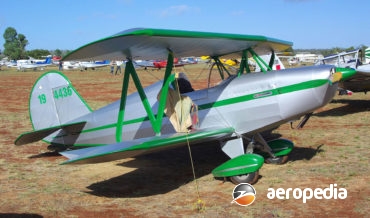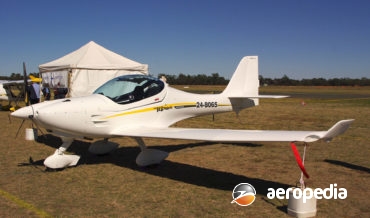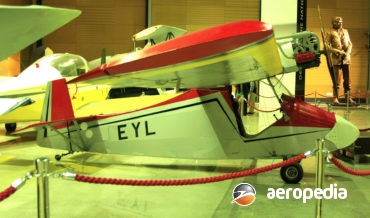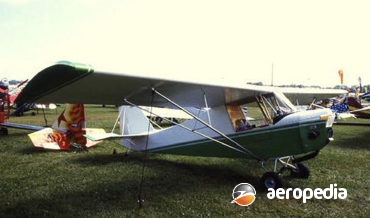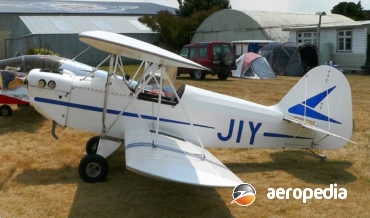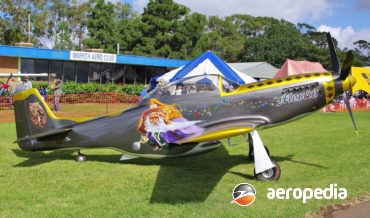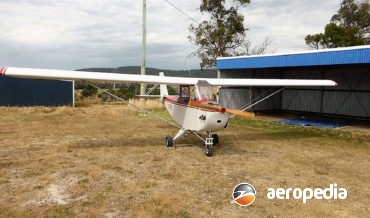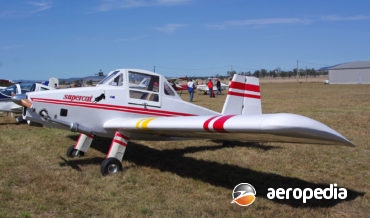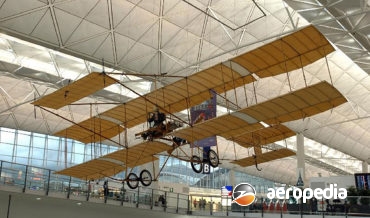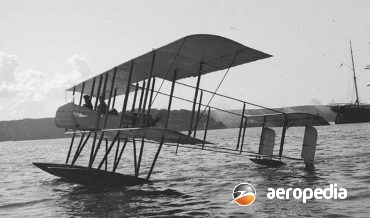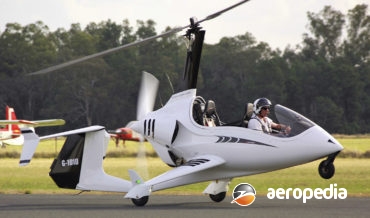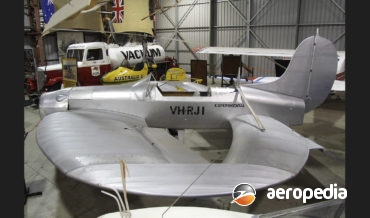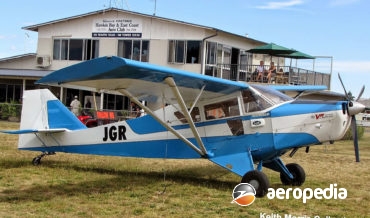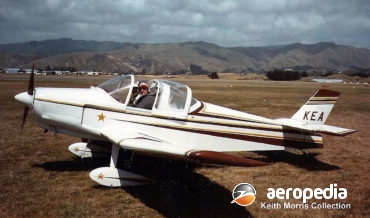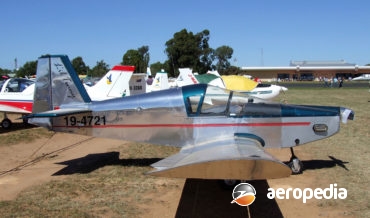All Contents
Contents
The RW-3 Multoplane was designed by Hanno O Fischer, a World War II fighter pilot, as a practical and economic means of transport for two, being a fully aerobatic light aeroplane
David C. Eyre
- May 8, 2019
Fisher Flying Products of Edgeley, North Dakota for some years has produced a range of light kit planes for amateur construction in the ultra-light category, and many examples of the series have been built and flown in Australia and New Zealand
David C. Eyre
- May 8, 2019
Spectrum Aviation was formed at Lismore, NSW in 1989 as an ultralight maintenance, flight training and sail manufacturing facility
David C. Eyre
- May 8, 2019
The R-80 is an 80% scale replica of the de Havilland DH-82A Tiger Moth manufactured and marketed in kit form by Fisher Flying Products of Edgeley, North Dakota
David C. Eyre
- May 8, 2019
The Avenger is part of a range of ultra-light aircraft produced by Fisher Flying Products of Edgeley, North Dakota in the US and is a single-seat monoplane with a Rotax engine of 30-kw (40-hp) but engines ranging up to 48-kw (65-hp) may be installed
David C. Eyre
- May 8, 2019
The Youngster was designed and is marketed by Fisher Flying Products of Edgeley, North Dakota, and is one of a range of light aircraft for construction by amateur builders
David C. Eyre
- May 8, 2019
The Celebrity is one of a number of kit type light aircraft which was originally built by Fisher Flying Products from its facility in Edgeley in North Dakota, the company later moving to a new plant at Woodbridge in Ontario, Canada
David C. Eyre
- May 8, 2019
The FK-9 series is produced in a number of models to meet customer requirements in Germany and the type has been distributed in this region by Silent Wings Aviation
David C. Eyre
- May 8, 2019
The Classic is one of a range of ultra-light aircraft produced in Canada in kit form by Fisher Flying Products and is marketed by the company from Edgeley, North Dakota, the first example making its first flight in 1987
David C. Eyre
- May 8, 2019
B & F Technik Vertriebs GmbH was founded in 1990 by two students, Otto and Peter Funk who set up a facility at Hofheim, moving later in 1995 to Speyer
David C. Eyre
- May 8, 2019
The Dakota Hawk is a two seat-side-by-side light aircraft produced by Fisher Flying Products of Edgeley, North Dakota in kit form
David C. Eyre
- May 8, 2019
The Scooter was designed by Mr K Flagor in July 1965 as a small ultra-light sporting monoplane for construction by amateur builders
David C. Eyre
- May 8, 2019
Flown for the first time in 1982 and released to the market as a kit shortly thereafter by Fisher Flying Products, the FP-101 was a popular cheap light aircraft around the world
David C. Eyre
- May 8, 2019
The Canuck commenced life in the 1940s as a light aircraft designed by Robert Noury and was initially known as the Noury N-75, the prototype making its first flight at Mount Hope in Ontario, Canada in 1944
David C. Eyre
- May 8, 2019
The FP-303 was designed by Fisher Flying Products as a low-cost ultralight, being designed by Fisher’s chief engineer as an ‘inexpensive yet a joy to fly, aircraft
David C. Eyre
- May 8, 2019
The FP-404 is one of a series of ultra-light aircraft produced by Fisher Flying Products of Edgeley, North Dakota in the United States
David C. Eyre
- May 8, 2019
The P-51D is one of a number of scaled down North American P-51 Mustangs available to amateur builders in the United States
David C. Eyre
- May 8, 2019
The FP-606 Skybaby was designed in 1986 to comply with the then FAR 103 Ultralight Vehicles category for light sporting aircraft, the category allowing a maximum empty weight of 115 kg (254 lb)
David C. Eyre
- May 8, 2019
Designed by Robert Baker, and built for the ultralight / microlight market, the Bobcat was a development of the company’s SuperCat, being a single-seat light sporting aircraft
David C. Eyre
- May 8, 2019
Fisher Flying Productions of Edgeley, North Dakota, has for some years produced a range of light kit aircraft for the amateur constructor, and quite a few examples of the series have been built in Australia and New Zealand
David C. Eyre
- May 8, 2019
As noted with the Fairchild 24W, the Model 24 series of three / four seat cabin monoplanes was introduced to the American market in 1931 by Fairchild Airplane & Engine Corp of Hagerstown, Maryland and became popular over the years, with some 17 different models being produced
David C. Eyre
- May 8, 2019
The Farman III, which has also been referred to as the Henri Farman 1909 or 1910 Biplane in order to distinguish it from aircraft built by his brother Maurice, was one of a series of aircraft designed and developed by Henri Farman in France from 1909, the design being copied
David C. Eyre
- May 8, 2019
The Fairchild 24 series of aircraft was introduced in 1931 The prototype, a two-seater, known as the KR Fairchild 24, had been flown early that year, and the first production model, the F24-C8 received its type approval in June 1932
David C. Eyre
- May 8, 2019
A Farman Shorthorn was imported in 1914 by well known Sydney businessman, Lebbeus Hordern and part of the Anthony Horderns empire which operated the large Anthony Horderns store in the city of Sydney
David C. Eyre
- May 8, 2019
The Fairchild 91 was a single-engined amphibian accommodating a crew of two and eight passengers in two cabins built from 1936 by the Fairchild Engine & Airplane Corp of Hagerstown, Maryland
David C. Eyre
- May 8, 2019
The Farman David was a light sporting biplane introduced to the aviation world via the 1919 Paris Salon
David C. Eyre
- May 8, 2019
The Model 45 produced by the Fairchild Corporation was known, when first introduced, as The Sedan of the Air and was aimed at meeting a market for a high-speed transport with good capacity, comfort and convenience normally associated with an expensive automobile
David C. Eyre
- May 8, 2019
The PAC 750 XLA is a development of the XL series for agricultural work, the initials XLA standing for Xtreme lift Advantage
David C. Eyre
- May 8, 2019
In the 1920s Sherman Fairchild was involved in the business of aerial photography and survey work, and found the aircraft available at the time not meeting his requirements
David C. Eyre
- May 8, 2019
The Fawcett 120 was a high-wing, all-metal monoplane designed by Luigi Pellarini in 1953 and built by Fawcett Aviation Pty Ltd of Bankstown, NSW
David C. Eyre
- May 8, 2019
The FH-1100 was the first American, light, turbine powered helicopter to be offered on the commercial market
David C. Eyre
- May 8, 2019
The ArrowCopter is a two-seat high performance gyrocopter produced in Austria to United Kingdom construction standard Section T CAP 643 which permits its construction up to a MTOW of 600 kg (1,322 lb), and in the ultralight class in Germany and other countries, up to a max of 450 kg
David C. Eyre
- May 8, 2019
The Furio is a two-seat light aircraft designed and developed by Giovani and Lapo Nustrini, Lapo Ancillotti, and Kevin Grant in Auckland, NZ, design of the aircraft commencing in about 2004, construction of the prototype beginning in early 2006
David C. Eyre
- May 8, 2019
The Circle is a radical design built in Sydney by Ronald J Feast Mr Feast spent many years designing and building model aircraft and in recent years has been working on models of a circular-wing aircraft
David C. Eyre
- May 8, 2019
The Maranda is one of a series of homebuilt designs produced by Falconar Avia Ltd of Edmonton, Alberta, the company’s designs including modern versions of the Mignet Flying Flee, variants developed from and similar to the Jodel D-11 series, and a scale P-51 Mustang
David C. Eyre
- May 8, 2019
Gerhard Fieseler was born near Cologne, Germany in 1886 [he died in 1987] and served as a fighter pilot during World War I, later becoming an aerobatic pilot In 1930 he purchased Segel Flugzeugbau, a glider manufacturer, and commenced to build and design further aircraft, including the very successful Fi
David C. Eyre
- May 8, 2019
The F-11, known as the ‘sporty’, was designed by Christopher Falconar in Canada for amateur builders and is built by Falconar Avia at Edmonton in Alberta and supplied in kit form or as plans
David C. Eyre
- May 8, 2019
The F-12 series was developed from the F-11 series which in turn was developed from the Jodel D-11The F-12 had an enlarged cockpit, simplified fittings and aerodynamic improvements which improve the aircraft’s stall characteristics
David C. Eyre
- May 8, 2019
The Li’l tinny is a single-seat all-metal scratch-built aircraft designed and flown by Mr Richard Faint It has a tricycle undercarriage and no kit or plans were available to the owner It uses a NACA 4415 wing section and has an aspect ratio of 61
David C. Eyre
- May 8, 2019
The Allegro is one of a series of ultra-light aircraft built at Pisek in the Czech Republic by Fantasy Air Ltd
David C. Eyre
- May 8, 2019
Recent Comments
Archives
Categories
- No categories
Categories
- No categories
Latest Posts
Newsletter

